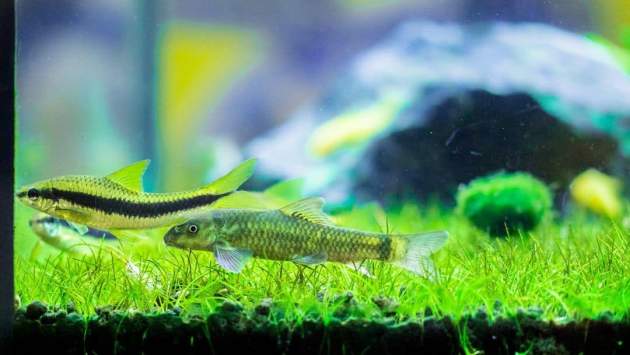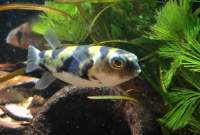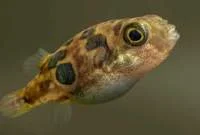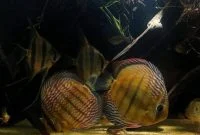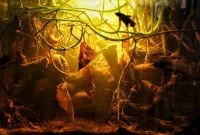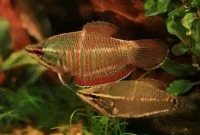Garra rufa fish is an unfamiliar algae eater crew that many hobbyists add these fish into their freshwater tank setup. Some people might be unseen them settle in home aquaria due to their function as fish therapy in spa industries.
Good to know, Garra rufa is excellent against the algae bloom inside the planted tank. Besides that, these fish can treat skin diseases in the same way as leeches, including psoriasis, eczema, dermatitis, heavy legs, and cleaning of wounds.
Israel is the biggest manufacturer that commercially supplies the Garra rufa into the aquaria and spa trades. Turkey also contributes in this part, although in a smaller number, because this country protects them legally from catching in the wild to prevent overharvesting.
This article fits to anyone who is looking for information about Garra rufa or starting to pet them, so continue to read.
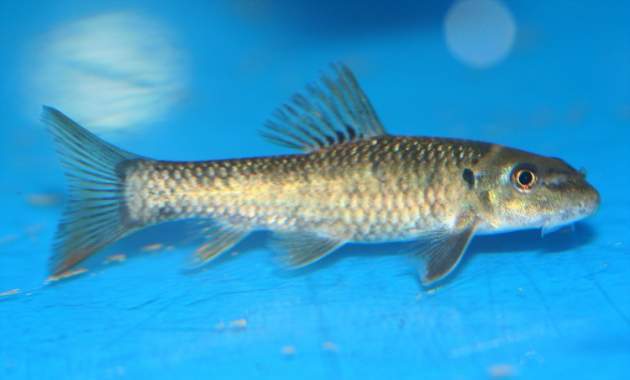
TABLE OF CONTENTS
Garra Rufa Overview
- Scientific Name: Garra Rufa
- Care Level: Easy – Intermediate
- Originate: Turkey, Syria, Iran, Iraq
- Size: Up to 14 cm
- Life Expectancy: Up to 7 years or more
- Diet: Algae eater and omnivore
- Temperament: Peaceful toward all tankmates
- Minimum Tank Size: 30 gallons
- Temperature: 14 – 20 °C
- pH Level: 6 – 8
- Water Hardness: 18-268 ppm
- Suitable For Newbie: Yes
General Information
Garra rufa (red garra) is an algae eater fish species under the family of Cyprinidae that originate from various freshwater habitat environments in subtropical territories of Western Asia.
There are three alternative names (common names) for describing this fish in the trade that is doctor fish, kangal fish, and nibble fish.
Their scientific name consists of two words, ‘Garra,’ which means vernacular gangetic name for a particular species of “sand-digger,” which is applied by Francis Buchanan-Hamilton as a generic name for the type of cyprinids bottom-dwellers that without affinity to another genus.
And another word, ‘rufa,’ is from Latin ‘rufus,’ which means ‘red, reddish,’ which refers to the reddish pigmentation on the head of some individuals.
These fish also have some synonyms names, including Discognathus crenulatus Heckel 1846–49; Discognathus lamta non-Hamilton 1822; Discognathus obtusus Heckel 1843; Discognathus rufus Heckel 1843; Garra rufa crenulata Heckel 1844; Garra rufa gymnothorax Berg, 1949.
The doctor fish have been introduced into spa treatment since the early 21st century due to their ability to alleviate the symptoms of psoriasis where they eat the stratum corneum skin layer of the patients with this disease.
However, the utilization of doctor fish for a spa treatment for the broader public is still controverted due to their effectiveness and validity.
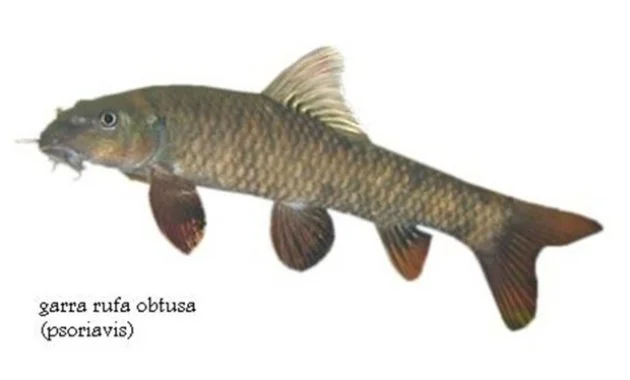
Distribution And Habitat
The Garra rufa algae eater is distributed into several regions in Mediterranian and Middle East, including Turkey, Iran, Iraq, and Syria.
Some main water streams where they are found include Kızıl, Seyhan, Ceyhan, Orontes/Asi, smaller Turkish water systems, Queiq/Qweik, the Jordan river drainage in Jordan and Israel (except the Southern Dead Sea basin, which is substituted by their congener Garra ghorensis), Tigris-Euphrates, Kor, and Mond river basins.
They also occupy most of the coastal watersheds in Syria and the endorheic lake Maharlu systems in southwestern Iran. The type locality of these species is in Aleppo, Syria.
Mostly, they live in fast-flowing streams in headwaters and tributaries; some colonize several larger, lowland river channels. They also populate other water bodies such as canals, ponds, lakes, and manufactured reservoirs.
In some cases, these fish occurs in ephemeral habitats that become partly desiccated through particular times of the year. Garra rufa algae eaters often are found to survive in some water zones that are heavily influenced by people, such as polluted canals.
Nibble fish tend to avoid the still water systems. Their favorite habitat in the wild are streams that contain clear and high oxygenated water, which is associated with the sunlight that promotes the development of submerged biofilm grows in rich.
Appearance Of Garra Rufa Algae Eater
Sometimes, in the same country of these fish origin, they probably consist of different populations of G. Rufa, which tends to vary in appearance, and a chance of hybridization with another species can not be ruled out either.
Nevertheless, doctor fish shows several similarities throughout the large portions of their range between each other.
Red garra’s fin and bodies vary in coloration. However, most of them have iridescent or dark blue patches at the upper edge of the opercle and another one on the caudal peduncle. Younger individuals can be distinguished by the prominent bluish color spots at the caudal peduncle.
On the base of their central dorsal-fin rays usually appears a series of dark markings. It often occurs in many specimens, the end of their upper caudal fin lobe is black.
That said, the population of Garra rufa from Iran and Iraq has some different characteristics as follows: they have two pairs of barbels; most of them possess 8 (87.1% for 534 specimens, range 6 – 8) branched dorsal-fin rays; and they own an adhesive disc on the lower head surface that grow well with free anterior margin.
Generally, these small freshwater fish species can reach up to 5.5 inches (14 cm) in total length. However, the captivity form rarely exceeds 3.6 inches (9 cm), while the wild type may grow larger around 9.5 inches (24 cm).
Even though they are not developed too large, the nibble fish known can live longer, more than seven years, under better maintenance.

Behavior And Temperament
Garra rufa algae eater fish are relatively peaceful; they can be kept with other species that need identical environmental conditions to live.
Unfortunately, they can be intolerant to conspecifics in a nano aquarium. But the aggression towards other fish is loose in the larger spaces or their wild habitat.
Doctor fish tending becomes more aggressive when putting with other similarly shaped fish if you are keeping them singly. Well, we suggested buying 4-6 fish or more and ensuring enough space.
Grouping like that will create a prominent pecking order between themselves; it would reduce the temperamental intensity between the members.
The reason that makes them are interesting they are very active and lively, always on the move. Garra rufa almost spent a whole day looking for food; their pair of barbels are helpful in this activity. Once in a while, they also hide near the stones or wood when stressed or relaxed.
These tropical fish are not timid species; without feeling fear of any strange object, they would observe and occasionally nibble it. If that contains some snacks that these fish can eat, Garra rufa will continue to nip it. This happens to customers’ hands or feet when fully submerged in their pond in the spa service.
They can be more boisterous during feeding time; then, the food disappears in a while.
Sexual Dimorphism
As much like most common freshwater fish, the females of Garra rufa are usually distinguished by their thicker bodies. On the contrary, mature males are smaller, thinner, and develop extensive tuberculated patches on their snout and head. While the genital papilla shape is visible during the spawning period, the male will show bridal buds on the top of their mouth and cheeks and have longer pectoral fins.
Reproduction
Garra rufa are very productive fish; they tend to reproduce continually for a slightly longer period. In the wild, spawning often happens between April and November; it includes the warm and rainy seasons.
Before starting to breed these fish, make sure to select the high-quality fish parents that can diagnose as follow:
- Having a good color and markings
- Choose healthy mature doctor fish.
- Only select the pairs from the same species to prevent hybridization.
Conditioning the parent fish is essential to reach the goal of resulting in the best babies. This process is feeding the Garra rufa algae eater with a variety of healthy food as well as live food.
The breeders usually use brine shrimps, bloodworm, insect larvae, moina, and other related meal types to get them into greatest condition when they spawn.
Should you know, the red garras are the egg-scattered type where they lay their adhesive or non-adhesive eggs into substrate, plants, decoration, or even leave them to float to the surface. Besides, they also do not look after their eggs or even can be consuming them.
Provide a separated breeding tank necessary to increase the reproduction rate. Use a 5 – 10 gallon tank size, install an air pump, sponge filter to create slow-moving water, and the tank should be equipped with a heater as well as keeping plenty of live aquatic or artificial plants and mops.
To avoid the predation of their parents, the substrate should consist of two layers of pebbles/marbles or a fine net from nylon above the aquarium floor.
Once the eggs are released, they will fall through the pebbles or net that the mature fish can not reach.
Raise the water temperature, decrease the tank water to half of the tank, and the ph level should be between 7-7.5.
Spawning usually occurs in the morning and produces 200 – 500 eggs; they measure only 1.5 – 1.88 mm and are transparent. After the matting, the parents should be moved to another tank.
The incubation period takes between 24 – 30 hours, depending on the temperature. Three sides of the breeding aquarium should be covered with the black paper due to light can promote the fungus to grow and make the fry are discomfort.
After the eggs hatch, the fry will spend their yolk sacks for around 72 hours before they can swim freely.
When it’s gone, the hungry fry will start to find food; they can be fed with infusoria, boiled egg yolk, or green water. Then after one week, they can accept larger food such as daphnia, artemia nauplii, or white worms.
At the age of fifteen days, the Garra rufa babies can eat dried food that is customized to their size or other larger live food like brine shrimps, larvae insects, and chopped tubifex worm.
Perform 2 or 3 times feeding sessions a day. To avoid cannibalism among the fry, do sorting by their size periodically.
A daily 25-50% water change is required to maintain the fry stay healthy. The new water must have the same characteristics as the water taken out; it is because the fry is sensitive to the water chemistry that changes suddenly. Do not forget to take out the sick and deformed fish.
Under favorable water conditions, a proper feeding diet, and water change periodically, the fry should grow well and faster.
Feeding And Diet
These species are easy to feed because they are omnivorous. In the natural environment, their primary diet commonly is most algae types (cladophora algae, fuzz algae, rhizoclonium algae, staghorn algae, oedogonium algae, green dust algae, green spot algae), detritus, and tiny animals such as zooplankton and arthropods.
In the home aquaria, offer them a conventional food type such as spirulina-based sinking pellets, algae wafers, vegetables (zucchini, spinach, cucumber, peas), and fresh fruits (melon). Completing their nutrition with live food encourages coloration, including artemia, shrimp meats, tubifex, or bloodworms.
Tank Requirements And Aquarium Setup
At least you should provide a 30-gallon tank size to cover six individuals; it will give enough space to them explore any corner spots entire the tank. You can add some similar sized-tankmates inside.
A perfect setup for them should resemble a river environment as their wild habitat. Commonly the substrate consists of various size rocks, fine gravels, sands, and maybe some boulders. Be sure the gravels or stones are not sharp because their barbels are fragile.
Create a bare space for them to search the ground. Arrange the rocks in such a way to build some hiding areas; in nature, they prefer to hide under the stones or vegetation to rest.
Completing the decorations with driftwood or branches as well as other kinds of stuff like pipes, vase, or everything you want. It offers many shade areas inside the aquarium.
Apply a filtration system to maintain the water consistently clean and well-oxygenated; we are advised to use a filter that can turn over the water more than ten times per hour.
Equipped the aquarium with other tools that can support the water cycle, such as powerheads and an aerator, to desire the flow and oxygenation if necessary. These fish do not need a heater except to stimulate them to breed.
There are no rules for light intensity, but strong lighting can promote the growth of biofilm at the surface that Garra rufa loves so much. It also can drive some algae species to thrive.
Putting some hardy aquatic plants such as anubias and cryptocoryne gives other benefits like enhancing oxygen levels and displaying a magnificent view. The floating live plants like salvinia natans can be added if required. Ensure to clean up them using parasite killers to avoid some harmful animals such as scuds and ramshorn snails.
Cover the planted aquarium with the tank lid; they are literally can jump out. Below is a formula for the water parameter that the Garra rufa fish prefer:
- Temperature Level: 14 – 20 °C
- pH Level: 6.0 – 8.0
- Water Hardness: 18 – 268 ppm
Maintenance And Care
They should not be added to the immature aquascape tank setup since they require stable water conditions and are developed with biofilm.
Doing a regular water change of about 30% weekly is obligatory in order to maintain the water in the same condition. You can add biofilm powder to boost its growth, which will make the Garra rufa happier.
You can leave their aquascaping tank uncompletely clean; it triggers the algae to become established. However, organic waste such as fish feces, decomposed plants matters, and dead creatures should be removed. This leads to many problems in your fish tank and is preferred by some aquarium parasites, including planaria flatworm, hydra and detritus worm.
In order to get algae stocks, you can produce them in a separate tank. Put some rocks inside, supply the bright lighting or place this tank outside. Leave the captivity tank until algae are spread on the surface of the rock. Enter the algae rocks into the Garra rufa tank, substitute the stones from the fish tank with it, then do a cycle to make the alga grow continuously.
Feed your Garra rufa algae eater fish 2 or 3 times a day. Giving their diet in small portions several times is preferable rather than in high amounts in one time.
Tankmates Of Garra Rufa Algae Eater
The compatible tankmates should have similar characteristics to the Garra rufa. Some tiny freshwater fish that we recommend are tetra species, mollies, rainbow fish, danio, dwarf gourami, licorice gourami, and other related fish types.
The slower-moving fish like discus and angelfish is really inappropriate; they may outcompete during feeding and might be bothered due to their swimming speed.
Never try putting some larger, territorial, aggressive fish such as oscar or flowerhorn. They would intimidate the red garra, making these fish very stressed.
Clearly, your tank should have sufficient spaces for them to avoid conflict between aquarium members.
Potential Diseases
Like most freshwater fish, they can be affected by common diseases, including white spots, fin roots, dropsy, fungus and bacterial infection. However, there is no species illness is known until this article written.
Availability
They tend to easily find on local breeders and online trades than in local fish stores. Because the Garra rufa is more used for spa industries, most aquarium shops prefer to choose to sell other famous algae eaters such as siamese algae eater or Chinese algae eaters.
The standard doctor fish usually costs about $3-$5 for an adult and healthy individual. But, some sellers probably offer a lower price for purchasing in groups.
Is Garra Rufa Fish Are Suitable For Newbies?
Yes, they are fit for a beginner because they are easy to keep and do not need many special requirements to thrive in the aquarium. Despite that, an inexperienced aquarist that straightforwardly tries breeding them is not suggested. They should learn a lot of information and need to get enough experience with these fish before doing that. Of course, it may take much time.

